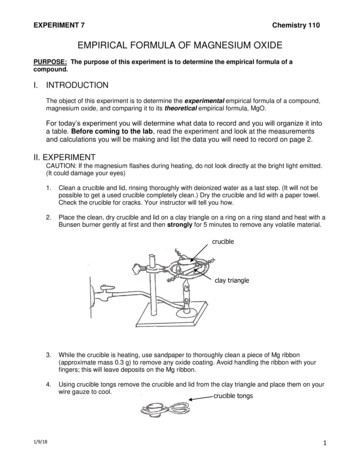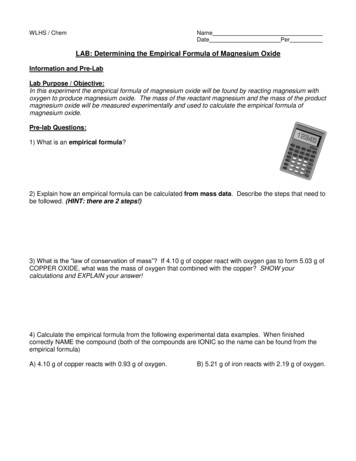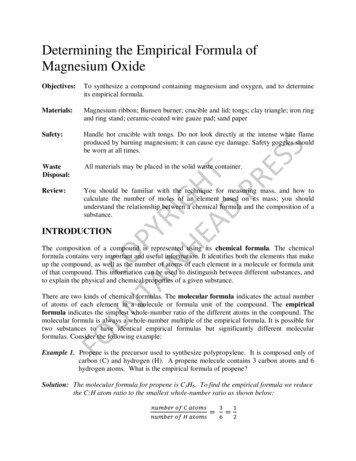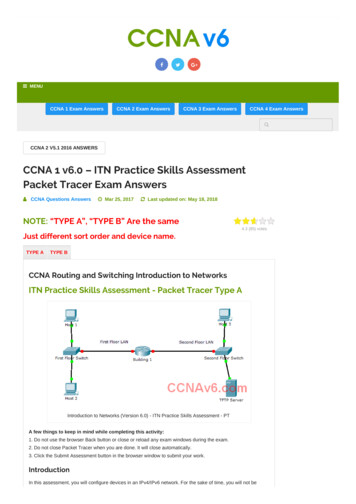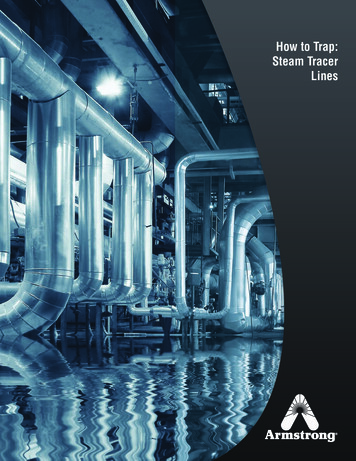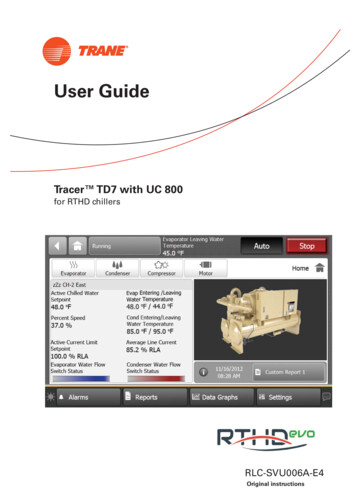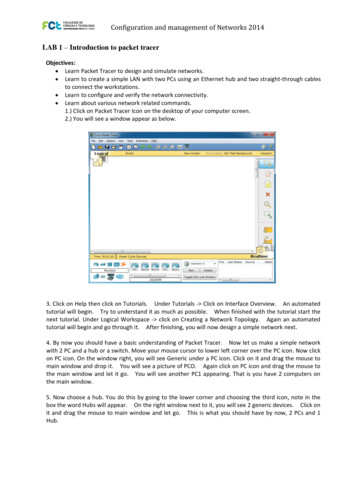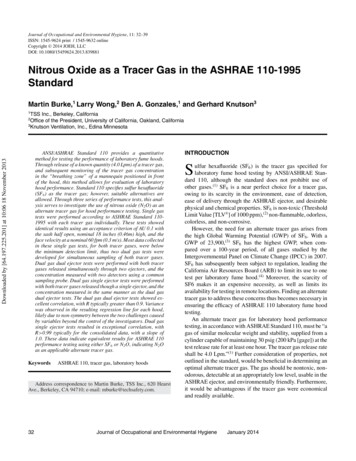
Transcription
Journal of Occupational and Environmental Hygiene, 11: 32–39ISSN: 1545-9624 print / 1545-9632 onlinec 2014 JOEH, LLCCopyright DOI: 10.1080/15459624.2013.839881Nitrous Oxide as a Tracer Gas in the ASHRAE 110-1995StandardMartin Burke,1 Larry Wong,2 Ben A. Gonzales,1 and Gerhard Knutson31TSS Inc., Berkeley, CaliforniaOffice of the President, University of California, Oakland, California3Knutson Ventilation, Inc., Edina Minnesota2Downloaded by [64.197.225.201] at 10:06 18 November 2013ANSI/ASHRAE Standard 110 provides a quantitativemethod for testing the performance of laboratory fume hoods.Through release of a known quantity (4.0 Lpm) of a tracer gas,and subsequent monitoring of the tracer gas concentrationin the “breathing zone” of a mannequin positioned in frontof the hood, this method allows for evaluation of laboratoryhood performance. Standard 110 specifies sulfur hexafluoride(SF6 ) as the tracer gas; however, suitable alternatives areallowed. Through three series of performance tests, this analysis serves to investigate the use of nitrous oxide (N2 O) as analternate tracer gas for hood performance testing. Single gastests were performed according to ASHRAE Standard 1101995 with each tracer gas individually. These tests showedidentical results using an acceptance criterion of AU 0.1 withthe sash half open, nominal 18 inches (0.46m) high, and theface velocity at a nominal 60 fpm (0.3 m/s). Most data collectedin these single gas tests, for both tracer gases, were belowthe minimum detection limit, thus two dual gas tests weredeveloped for simultaneous sampling of both tracer gases.Dual gas dual ejector tests were performed with both tracergases released simultaneously through two ejectors, and theconcentration measured with two detectors using a commonsampling probe. Dual gas single ejector tests were performedwith both tracer gases released though a single ejector, and theconcentration measured in the same manner as the dual gasdual ejector tests. The dual gas dual ejector tests showed excellent correlation, with R typically greater than 0.9. Variancewas observed in the resulting regression line for each hood,likely due to non-symmetry between the two challenges causedby variables beyond the control of the investigators. Dual gassingle ejector tests resulted in exceptional correlation, withR 0.99 typically for the consolidated data, with a slope of1.0. These data indicate equivalent results for ASHRAE 110performance testing using either SF6 or N2 O, indicating N2 Oas an applicable alternate tracer gas.KeywordsASHRAE 110, tracer gas, laboratory hoodsAddress correspondence to Martin Burke, TSS Inc., 620 HearstAve., Berkeley, CA 94710; e-mail: mburke@techsafety.com.32INTRODUCTIONSulfur hexafluoride (SF6 ) is the tracer gas specified forlaboratory fume hood testing by ANSI/ASHRAE Standard 110, although the standard does not prohibit use ofother gases.(1) SF6 is a near perfect choice for a tracer gas,owing to its scarcity in the environment, ease of detection,ease of delivery through the ASHRAE ejector, and desirablephysical and chemical properties. SF6 is non-toxic (ThresholdLimit Value [TLV ] of 1000 ppm),(2) non-flammable, odorless,colorless, and non-corrosive.However, the need for an alternate tracer gas arises fromthe high Global Warming Potential (GWP) of SF6 . With aGWP of 23,900,(3) SF6 has the highest GWP, when compared over a 100-year period, of all gases studied by theIntergovernmental Panel on Climate Change (IPCC) in 2007.SF6 has subsequently been subject to regulation, leading theCalifornia Air Resources Board (ARB) to limit its use to onetest per laboratory fume hood.(4) Moreover, the scarcity ofSF6 makes it an expensive necessity, as well as limits itsavailability for testing in remote locations. Finding an alternatetracer gas to address these concerns thus becomes necessary inensuring the efficacy of ASHRAE 110 laboratory fume hoodtesting.An alternate tracer gas for laboratory hood performancetesting, in accordance with ASHRAE Standard 110, must be “agas of similar molecular weight and stability, supplied from acylinder capable of maintaining 30 psig (200 kPa [gage]) at thetest release rate for at least one hour. The tracer gas release rateshall be 4.0 Lpm.”(1) Further consideration of properties, notoutlined in the standard, would be beneficial in determining anoptimal alternate tracer gas. The gas should be nontoxic, nonodorous, detectable at an appropriately low level, usable in theASHRAE ejector, and environmentally friendly. Furthermore,it would be advantageous if the tracer gas were economicaland readily available.Journal of Occupational and Environmental HygieneRJanuary 2014
TABLE I. Properties of Tracer GasesPropertySulfur HexafluorideCASMolecular weightACGIH TLV NIOSH RELToxicityStabilityOdorCorrosivityMinimum Detection LevelBackgroundGlobal Warming Potential (GWP)2511-62-4146 gm/mole1000 ppm1000 ppmNon-ToxicStableNoneNon-corrosive0.01 ppmNegligible22,200Downloaded by [64.197.225.201] at 10:06 18 November 2013RRNitrous OxideNitrous oxide (N2 O) has the necessary characteristics foran alternate tracer gas as specified by ASHRAE Standard 110.N2 O is also cost-effective and easily acquired, with beneficialqualities for an alternate to SF6 . Comparison of the physicalproperties of SF6 and N2 O is presented in Table I.Molecular WeightThe molecular weight of the gas used in ASHRAE Standard110 testing affects the mass flow through the ejector, and thebehavior of the plume subsequently generated. As the tracergas exits the orifice, it entrains air into the ejector. The air-gasmixture forms a plume that exits the ejector top. Intuitively, thesize of the plume is critical to the test because grossly differentplumes could result in different hood challenges.This investigation used 0.025-inch (0.63 mm) orifices asspecified by Standard 110, and a calibrated piston meter tomeasure the flow through the orifice at a range of pressures. Anupstream pressure of about 30 psig (200 kPa [gage]) is requiredto achieve 4.0 Lpm for SF6 . N2 O required approximately 9 psig(62 kPa [gage]) for the same flow.Although it is easy to measure the flow through the orificealone, it is difficult to measure the total flow of the tracer gasand the entrained air. A flow box, as seen in Figure 1, wasused to measure the total flow. The flow box was used formeasurement of the air entering the ejector through a long,straight entry tube. A rotary vane anemometer was used tomeasure the flow through the tube. The differential pressurebetween the test lab and flow box was monitored to determineany significant reduction in airflow due to the box. Such losseswere negligible and the results allowed for determination ofthe size of the ejector plumes. As shown in Figure 2, 4.0 Lpmof tracer gas produced a total volumetric flow of approximately700 Lpm and 400 Lpm, for SF6 and N2 O, respectively. Theflow box confirms a difference in the volume of the plumes.The lower volume of the N2 O plume implies a higher concentration of N2 O in its smaller plume when compared to SF6 .Nitrous Oxide10024-97-244 gm/mole50 ppm25 ppmToxic at high concentrationStableNone at moderate concentrationNon-corrosive0.01 ppm0.32 ppm and variable296ToxicityN2 O has been in use as an anesthetic gas for over 150 yearswith limited noted adverse effects, beyond its association withasphyxiation. Anesthetic applications of N2 O are often 50%–80% by volume (500,000 ppm to 800,000 ppm). Recent studieshave shown high, but not anesthetic, levels of N2 O are associated with spontaneous abortions, neuropathy, and embryotoxicity/fetotoxicity when N2 O anesthetic waste gas is releasedinto the workspace. Based on available literature, ACGIH (2)has established an N2 O TLV of 50 ppm.All tests performed in this study showed no leakage into thelaboratory itself; however, there is a possibility of exposure toothers in the building. Therefore, when using N2 O as a tracergas, it is critical to understand the building ventilation system,and the interaction of the fan systems. For example, any fumehood exhaust system exceeding 5,600 acfm (2.6 actual m3/s)will dilute the tracer gas to less than 25 ppm in the exhaustwhile the ejector is operating at 4.0 Lpm. For low volumesystems, it is important to coordinate with facilities staff at ornear the exhaust fan discharge to minimize potential exposure.Likewise, in buildings with reentry potential, the extent ofpotential exposure should be discussed with the health andsafety staff to reduce potential exposure.To minimize potential exposures to N2 O, certain administrative controls are recommended. Testing should be coordinated with the client, laboratory staff, EH&S, and facilitiesdepartments prior to conducting tests. The detectors should beoperated with the audible alarm active at all times. If the facevelocity or smoke visualization tests do not conform to thedesign parameters, or if the instrument alarms, the test shouldbe terminated. Consider the use of additional tracer gas detectors as needed to monitor any areas where the concentrationof N2 O may increase.RRStabilityNitrous oxide itself is stable, and effectively non-reactive,at room temperature and any elevated temperature expectedin a laboratory hood. Although nitrous oxide is an oxidizerJournal of Occupational and Environmental HygieneJanuary 201433
FIGURE 1.Downloaded by [64.197.225.201] at 10:06 18 November 2013at elevated temperature, it is not flammable. At the 4.0 Lpmrelease rate, it does not affect the lower explosive level of thelocal air envelope.Background ConcernsN2 O is always present in air. It is generated by severalhuman and natural activities. The background level depends onlocation and varies throughout the day. Major sources of N2 Oinclude agriculture practices, especially the use of commercialand organic fertilizers, fossil fuel combustion, nitric acid production, and biomass burning. Although the background levelfluctuates by region and throughout the day, the average globalbackground level is approximately 0.32 ppm.(5)The background was high enough that it cannot be ignored.However, if the variability is small relative to the acceptablelevel, the effect of background can be neglected. Figure 3presents the N2 O background level for one representative hoodat the site of testing in Riverside, California, on April 27,2010.Over the nearly four hours of testing, the change in background was greater than the acceptance level (AU 0.1) requiredby Cal/OSHA.(6) However, since the test takes less than 6 minat each position, variation was observed over a 10-min period.A relative frequency histogram for the variation in N2 O levelsof the representative hood presented in Figure 3, during theobserved 10-min periods, is presented in Figure 4. The dataFIGURE 2.34Total flow through the ejector.Flow Box.show nearly all 10-min periods had a variation of less than0.03 ppm.Minimum Detection LevelThe infrared spectrophotometer used for testing has a minimum detection level (MDL) of 0.03 ppm, as published bythe instrument manufacturer. Based on the background datatests, it is clear that the MDL claim is conservative. Infraredspectrophotometers used in the tests are “portable;” however,the instruments were used in a stationary mode during testing.This improved the MDL. Based on the data collected forbackground, it was found that the MDL for performance testingwith N2 O should be 0.01 ppm.FIELD TESTSSingle Gas TestsMethodsSingle gas tests were conducted on thirty bench top hoodswith a vertical sash using SF6 and N2 O tracer gases. Eachhood was tested with the sash at a nominal 18 inches (0.46 m)above the work surface, and the face velocity set at a nominal60 fpm (0.3 m/s) according to ASHRAE Standard 110-1995.The face velocity of each hood was measured, and smokevisualization methods were used as described in Standard 110.The performance tests for each hood were conducted onceusing 4.0 Lpm of SF6 and once using 4.0 Lpm of N2 O. Thetracer gases were released from the three positions prescribedby Standard 110.Results and DiscussionAn acceptance level of AU 0.1 ppm was set for all singlegas tests. Two of the 30 hood tests performed exceeded thisacceptance, and 28 were below the acceptance level for bothtracer gases. Twenty-seven of the hood tests were at, or below,the MDL for each tracer gas. Using this acceptance criterionof AU 0.1 ppm, the results of the single gas tests were typicalof laboratory hoods designed and set to operate near 60 fpmand identical for both tracer gases Due to the preponderanceof tests at the limit of detection, comparison data needed toevaluate N2 O against SF6 could not be collected via singlegas testing. To overcome this issue, two dual gas test methodsJournal of Occupational and Environmental HygieneJanuary 2014
Downloaded by [64.197.225.201] at 10:06 18 November 2013FIGURE 3. N2 O Background of one representative hood inRiverside during testing on April 27, 2010.were devised, allowing for sampling of both tracer gases simultaneously. The conditions were slightly modified for dual gastesting, with the sample probe placed closer to the sash openingto provide measurements over a range of concentrations to havea robust comparison of N2 O and SF6 .Dual Gas Dual Ejector TestsMethodsDual gas dual ejector tests were performed on 10 hoods. A50-min test was conducted on each hood, and the data parsedinto 10 5-min sets. Two ejectors were placed side by side.One ejector discharged 4.0 Lpm of SF6 , the other discharged4.0 Lpm of N2 O. To increase the challenge to the hood, dualgas dual ejector tests were performed with the sash full open,28.5 in (0.72 m). The VAV system modified the airflow toachieve a nominal face velocity of 60 fpm (0.3 m/s). The lowface velocity and the larger opening contributed to increasedcontrol levels (decreased performance).Using two ejectors necessarily modified the geometry ofthe test. The ASHRAE Standard 110 specifies the distancefor both the mannequin and t
Nitrous Oxide as a Tracer Gas in the ASHRAE 110-1995 Standard Martin Burke,1 Larry Wong,2 Ben A. Gonzales,1 and Gerhard Knutson3 1TSS Inc., Berkeley, California 2Office of the President, University of California, Oakland, California 3Knutson Ventilation, Inc., Edina Minnesota ANSI/ASHRAE Standard 110 provides a quantitative method for testing the performance of laboratory fume hoods. Through .
